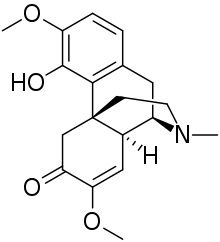Sinomenine
Sinomenine or cocculine is an alkaloid found in the root of the climbing plant Sinomenium acutum which is native to Japan and China. The plant is traditionally used in herbal medicine in these countries for rheumatism and arthritis.[1] However, its analgesic action against other kinds of pain is limited. Sinomenine is a morphinan derivative, related to opioids such as levorphanol and the non-opioid cough suppressant dextromethorphan. Its anti-rheumatic effects are thought to be primarily mediated via release of histamine,[2] but other effects such as inhibition of prostaglandin, leukotriene and nitric oxide synthesis may also be involved.[3]
 | |
| Clinical data | |
|---|---|
| Other names | Cocculine |
| ATC code |
|
| Identifiers | |
IUPAC name
| |
| CAS Number | |
| PubChem CID | |
| ChemSpider | |
| ChEMBL | |
| ECHA InfoCard | 100.003.722 |
| Chemical and physical data | |
| Formula | C19H23NO4 |
| Molar mass | 329.390 g/mol g·mol−1 |
| 3D model (JSmol) | |
SMILES
| |
InChI
| |
| | |
See also
- Hasubanan
- Oreobeiline
References
- Zhao, ZZ; Liang, ZT; Zhou, H; Jiang, ZH; Liu, ZQ; Wong, YF; Xu, HX; Liu, L (2005). "Quantification of sinomenine in caulis sinomenii collected from different growing regions and wholesale herbal markets by a modified HPLC method". Biological & Pharmaceutical Bulletin. 28 (1): 105–9. doi:10.1248/bpb.28.105. PMID 15635172.
- Yamasaki, H (1976). "Pharmacology of sinomenine, an anti-rheumatic alkaloid from Sinomenium acutum". Acta Medica Okayama. 30 (1): 1–20. PMID 61710.
- Liu, L; Riese, J; Resch, K; Kaever, V (1994). "Impairment of macrophage eicosanoid and nitric oxide production by an alkaloid from Sinomenium acutum". Arzneimittel-Forschung. 44 (11): 1223–6. PMID 7848335.
This article is issued from
Wikipedia.
The text is licensed under Creative
Commons - Attribution - Sharealike.
Additional terms may apply for the media files.